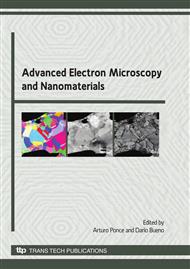p.1
p.9
p.13
p.17
p.21
p.25
p.29
p.33
Effect of Type and Concentration of Ionomer Compatibilizer on the Hdpe/ Ionomer/ Clay Nanocomposites Morphology
Abstract:
A study of the effect of an ionomer compatibilizer (surlyn® 9520 and 9721, both with zinc as the neutralizing cation) on the morphology and properties of a high density polyethylene (HDPE) - montmorillonite clay nanocomposite was carried out. The nanoclay used was cloisite 20A®. Polyethylene /Ionomer /Clay nanocomposites were prepared via melt mixing in a twin screw extruder. The nanoclay dispersion and exfoliation were examined through X-Ray Difraction (XRD) and Scanning Electron Microscopy (SEM). TGA was carried out to determine the effect of nanoclay on the thermal stability of the HDPE nanocomposites. Results showed that both ionomers impart a marked compatibility between the polymer and the nanoclay, promoting the exfoliation of the nanoclay within the HDPE matrix. Nonetheless, ionomer 9520 (with the higher degree of neutralization) at 10 and 12 wt% content produced completely exfoliated morphologies, whereas, the ionomer 9721 produced a lesser degree of exfoliation with few tactoids.
Info:
Periodical:
Pages:
17-20
Citation:
Online since:
March 2010
Price:
Сopyright:
© 2010 Trans Tech Publications Ltd. All Rights Reserved
Share:
Citation:


